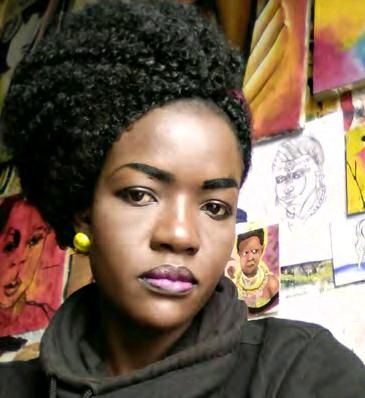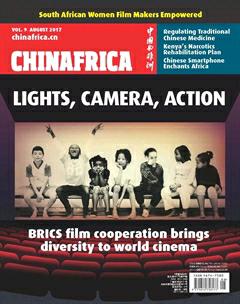From Rags to Canvas
By+Li+Xiaoyu
ART can be found in the most unlikely of places. Nairobi, the Kenyan capital, is home to the largest African slum: Kibera. More than 800,000 inhabitants are squeezed in the 2.5-square-km area with poor conditions and an average daily income of just one dollar. But in spite of all these problems, local artists find the strength to create and disseminate cutting-edge artworks.
Faith Atleno Owinio, 27, is one of them. Born in Kibera, this single mother runs a small art gallery in Kibera, where she teaches art to about 30 young people on a daily basis. Her unique technique is to use her fingers, instead of a brush, to mix the colors and paint: it is her own way of expressing emotions through her fingertips. In her paintings, she reinvents the places around her, whether it be Kibera, Nairobi or the African continent, and attempts to capture on canvas the ideal world of her dreams. As a politically-aware artist, Owinio also denounces injustice, discrimination and pressure that women face in the slum.
Owinios works have now spread far beyond the borders of her native Kibera. At an exhibition held last June at Hangzhous Grand Theater, in southeast Chinas Zhejiang Province, her paintings were exposed among 71 art works from the largest slum in Africa, giving Chinese art lovers a taste of her unique take on life.
A tough start
Raised single-handedly by her mother in a family of five children, Owinio had to look after her siblings from an early age. With the support of an NGO, she managed to pursue her studies all the way to high school where her creativity attracted the attention of a teacher, who gave her painting materials.
Having caught the bug of painting, Owinio began to indulge in her new passion. But her financial situation also meant she was unable to attend art classes at the local university. She eventually found work in a local art gallery. During the day, she used to secretly observe the artists and try to assimilate their basic skills and techniques.
In the evening, for lack of materials, she could only recreate the mixture of colors in her mind. “Although most of what I know I have learned by myself, I feel grateful to all the artists in these galleries. Observing them paint taught me lot,” Owinio told ChinAfrica.
After a year, Owinio finally decided to expose her paintings. But things quickly turned sour. Her works were stolen by an agent who lured her into an exhibition in Australia. The gallery eventually went bankrupt, and the artists project ran aground.
She found herself forced to make a living by working as a waitress in a restaurant. But despite these trials, her passion for painting never waned. After the birth of her son, she heard about Uweza Art Gallery in Kibera and joined the project in 2014. A new chapter in her artistic life opened.
A new beginning
Uweza Art Gallery is one of many initiatives of Uweza Foundation, a Kenyan NGO. In Swahili, uweza means “aptitude” or “empowerment.” Indeed, the foundation makes sure that all of its programs are developed or managed by Kenyans, and in particular by inhabitants of Kibera who are committed to transforming their community. In Uweza, local artists have access to all the tools they need, right at their fingertips. This is a great opportunity for Owinio and most local artists, for whom art materials would be otherwise hard to come by. In addition, Owinios paintings can now be sold on local and international markets using the NGOs own reliable sales network.
“By providing community members with the means to realize their ideas, we believe the impact of our work will be sustainable,” said Jen Sapitro, Executive Director and co-founder of Uweza Foundation. Owinio, who is now in charge of the art program, could not agree more: “Thanks to Uweza, art has become a viable career choice for me.”
She is now among the gallerys 12 resident artists. In addition to designing their own works, Owinio and her colleagues also play the role of teachers and promoters of Kiberas own brand of art. Approximately 30 teens, aged 12 to 15, attend weekly classes at Uweza Foundation.
As the person in charge of the program, Owinio teaches the basic principles of drawing to her students. “Few schools in Kibera integrate art classes into their curriculum. Children with artistic talent often lack opportunities to develop and cultivate their gift. Its a pity for them,” she lamented. “With Uweza, I know I can make a difference.”
Still much to overcome
But financial problems are not the only hurdles Kiberas artists have to face. As her familys elder, she should have assumed the responsibility of caring for her entire family. In their eyes, becoming an artist is far from being a reasonable choice and Owinio is struggling to win their support.
Moreover, she must deal with certain prejudices against women artists. “If I have chosen to become a painter, it is because I wish to set an example for all young girls living in slums who share the same aspirations as me. I would like to show them that becoming a teacher or doing business is not the only way out of poverty. We can also make a difference with art,” she told ChinAfrica.
This is what she expresses in her works, where she paints the everyday life of Kibera in all its beauty, including scenes of joy, sorrow and portraits of African women.
“When I was little, I was despised because my skin was darker. Some people even made me feel I was not beautiful. But I disagree!” said Owinio. “Black, in my opinion, can also be an inexhaustible source of beauty. That is why I want to show it in my works. And I am proud of it.”

